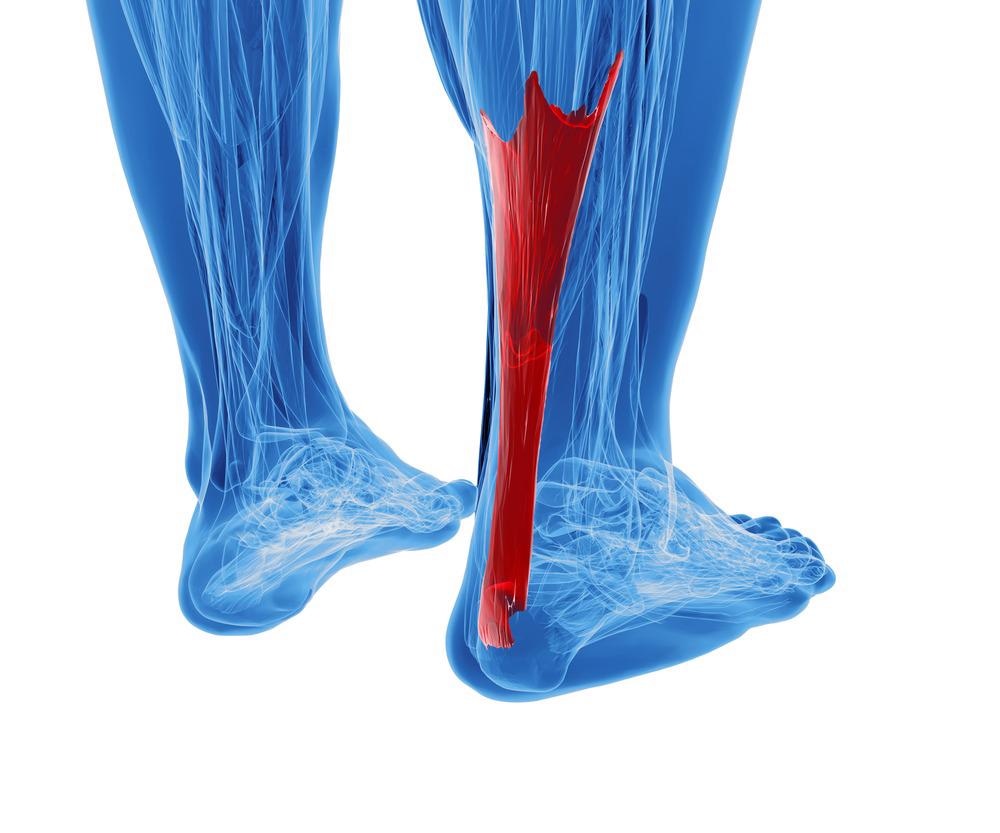Providing innovative treatments using advanced materials and technologies is a cornerstone of modern medical research and materials science. Biodegradable polymer materials have been widely explored over the past few years for the treatment and repair of tissues and organs, and a new study published in Frontiers in Materials has investigated repairing Achilles tendon injuries with these advanced materials.

Study: Research Progress of Biodegradable Polymers in Repairing Achilles Tendon Injury. Image Credit: goa novi/Shutterstock.com
Achilles Tendon Injuries
The Achilles tendon is located in the lower leg, where it attaches the calf muscle to the heel bone. The largest and most powerful tendon in the body, it has limited regenerative capacity in adult mammals. Injuries to the Achilles tendon and damage to the soft tissue and ligaments around it can cause serious problems such as the loss of flexibility and muscle strength. Severe fractures of the tendon require surgical intervention and treatment.
Achilles tendon injuries in sports and physical training are commonplace and can lead to dysfunction and disability, which can last for several years. Studies have shown that more than 70% of all Achilles tendon injuries occur in sports activities. Complications such as tendon re-rupture after an injury are not uncommon, with the postoperative re-rupture rate around 1.7-5.6%. Autologous transplantation is commonly used to treat and repair Achilles tendon injuries. However, morbidities and further weakness can occur after repair with this treatment.
Tissue Engineering Approaches
Tissue engineering is a recent advance in medical science that has become an increasing research focus for repairing damaged soft tissues, organs, skeletal tissues, muscles, and other tissues. Due to the complications associated with conventional treatments, tissue engineering has been proposed for the repair of Achilles tendons and the surrounding ligaments and soft tissues.
There has been significant research focus on manufacturing safe, non-toxic, and effective scaffold materials for use in tissue engineering for Achilles tendon injury repair. Collagen is the principal natural material that comprises tendons, therefore collagen has become a popular scaffold material for this purpose. Other biologically-derived scaffolds have been investigated alongside collagen, including alginate-chitosan polyion hybrid fibrous complexes, but in recent years research has turned to biodegradable synthetic materials.
Synthetic materials explored for tissue engineering include polyglycolic acid and polylactic acid and their copolymers. Glycolic acid and lactic acid, which are degradation products of polymers, are metabolites that are present naturally in the human body, but they are acidic and can cause inflammation, which is a major downside of using these polymers for tissue engineering.
In contrast, polymers such as polydioxanone and poly(trimethylene carbonate) degrade into non-acidic products, which makes them more attractive targets for repairing Achilles tendon injuries with tissue engineering. Proper selection of biodegradable polymers and regulation of their performance is key to tissue engineering strategies and the effective repair of Achilles tendons.
More from AZoM - Engineering Innovation: Showcasing Women in STEM
The Study
The study published in Frontiers in Materials has provided an extensive review of tissue engineering with synthetic biodegradable polymers for the repair of Achilles tendon injuries. Research progress into polymers such as PCL, PLGA, PLA, PDS, and PTMC as scaffolds containing stem cells or drugs for tissue engineering are discussed in depth in the study.
Currently, polymers utilized as scaffold materials have issues with biocompatibility and biodegradability. Additionally, they can possess poor mechanical properties which cause issues during processing and molding methods. These issues hinder their widespread commercial applications and warrant further research to realize their potential as tissue engineering scaffolds to repair Achilles tendons, although there has been considerable progress in research recently.
Further problems related to using biodegradable polymers for this purpose have been identified and discussed by the authors. Firstly, there is the question of the adverse effect on patient health. Secondly, can tissue-engineered polymer scaffolds produce ideal therapeutic results in both animal and human models? Finally, there is the question of how native and regenerated Achilles tendon tissue differ in terms of their biomechanical and physiological properties.
The above questions need to be resolved before synthetic biodegradable polymers can be widely applied as tissue engineering scaffolds for Achilles tendon repair. Work will need to be done on producing synthetic and modified natural polymers that meet the physiological, mechanical, and physiochemical requirements of scaffold materials. This will require continued cooperation between the fields of life sciences and materials science.
Through multi-disciplinary cooperation, ideal materials for use in the repair of Achilles tendon injuries using tissue engineering will doubtless be achieved in the coming years. The potential for simpler, safer, more straightforward treatments using non-toxic, biocompatible, and degradable polymers with less risk of post-operative complications can be realized, which will improve the recovery rate and clinical outcome for patients.
Further Reading
Zhang, J et al. (2022) Research Progress of Biodegradable Polymers in Repairing Achilles Tendon Injury [online] Front. Mater. 9 | frontiersin.org. Available at: https://www.frontiersin.org/articles/10.3389/fmats.2022.815930/full
Disclaimer: The views expressed here are those of the author expressed in their private capacity and do not necessarily represent the views of AZoM.com Limited T/A AZoNetwork the owner and operator of this website. This disclaimer forms part of the Terms and conditions of use of this website.